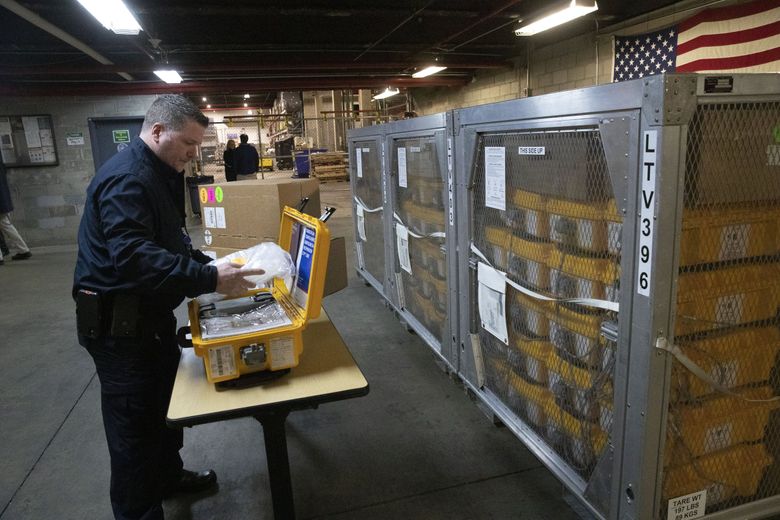Washington sending over 400 ventilators for non-coronavirus patients to New York, harder hit states
April 5, 2020 at 12:39 pm Updated April 5, 2020 at 3:53 pm
 Vincent Dellova, a coordinator at the New York City Emergency Management Warehouse, packs up a ventilator, part of a shipment of 400, that arrived Tuesday, March 24,... (Mark Lennihan / AP) More
Vincent Dellova, a coordinator at the New York City Emergency Management Warehouse, packs up a ventilator, part of a shipment of 400, that arrived Tuesday, March 24,... (Mark Lennihan / AP) More
By
Seattle Times staff reporter
Washington will return more than 400 of the 500 ventilators it recently received from the federal government, so they can go to New York and other states harder hit by the coronavirus crisis, Gov. Jay Inslee said Sunday.
After requesting 1,000 ventilators from the Strategic National Stockpile, Washington last month received 500.
The National Stockpile ventilators are not suitable for treating COVID-19 patients, state officials said. That’s because those individuals generally need a higher amount of pressure support into their lungs than the ventilators from the national stockpile can provide, said Jessica Baggett, a spokeswoman for the state’s Joint Information Center.
The stockpile ventilators, though, can be used for other patients, freeing up more COVID-19 compatible ventilators to help with the crisis.
The decision to return the ventilators comes five weeks after the first coronavirus death in Washington, when Inslee declared a state of emergency. It offers a glimmer of hope that the drastic steps the state has taken since then — shutting down schools and nonessential businesses and grinding daily life to a halt — have helped forestall the bleakest possible outcomes.
Dr. Raquel Bono, the retired Navy vice admiral leading the state’s coronavirus response, said in a statement that they’d made the decision to send off the ventilators after conferring with the Washington State Hospital Association. She said the state’s aggressive social-distancing actions have slowed the virus’ growth here.
“We have seen fewer infections in our communities than anticipated,” Bono said. “Our current status allows us to help others who have a more immediate need.”
Hospitalizations for patients with COVID-19-like illnesses declined by more than 20% in Washington in the last week of March, a small hopeful sign. And the Army Corps of Engineers has built a 250-bed field hospital at the CenturyLink Field Event Center to handle a potential overflow of non-COVID patients.
All 500 ventilators from the national stockpile had been distributed to hospitals across the state, a spokeswoman said, and the state was in the process of recalling them Sunday. Washington has also purchased more than 750 ventilators, which are expected to arrive over the next several weeks, Inslee’s office said.
“I’ve said many times over the last few weeks, we are in this together,” Inslee said in a prepared statement Sunday. “This should guide all of our actions at an individual and state level in the coming days and weeks.”
At the same time, on Sunday, Inslee reiterated his call for President Donald Trump to order the nation’s manufacturers to start producing more masks, face shields and testing materials. He faulted the Trump administration for what he called a lack of leadership during the pandemic, leaving states to scramble and compete with each other for such protective equipment.
“I mean, the surgeon general alluded to Pearl Harbor,” Inslee said on “Meet The Press” on Sunday. “Can you imagine if Franklin Delano Roosevelt said, ‘I’ll be right behind you, Connecticut. Good luck building those battleships.’”
Cassie Sauer, president and CEO of the Washington State Hospital Association, said hospitals here are not experiencing the dire needs for ventilators that New York hospitals are seeing.
“Sending some of our ventilator supply where it was immediately needed seemed like the right thing to do to support others across the country,” Sauer said.
Judith Malmgren, a Seattle epidemiologist, said Washington seems to be in good shape to send the ventilators back, even though we’re not seeing the number of new daily confirmed cases decline yet.
“They’re stable and the number of beds and the hospitals are not over capacity,” Malmgren said. She also noted that a majority of confirmed cases are now in people younger than 60, meaning they’re less likely to require hospitalization, a reversal since the earliest days of the crisis.
Dr. Arnold Monto, a professor of epidemiology and global health at the University of Michigan, said the state’s return of the ventilators was a cause for optimism.
“Seattle did what it needs to do,” Monto said. “The important thing is to watch the curve. The peak may be of different height in different places because of local factors.”
Washington joins Oregon, which on Saturday announced it would send 140 ventilators to New York, as states that have managed to slow new infections enough that the most dire predictions may be averted.
“We’ll be sending 140 ventilators to help NY because Oregon is in a better position right now,” Oregon Gov. Kate Brown tweeted Saturday. “Oregon doesn’t have everything we need to fight COVID-19 — we need more PPE and testing — but we can help today with ventilators. We are all in this together.”
Inslee has also been very cautiously hopeful.
“We have had some success flattening the curve. That has taken place because we acted relatively early,” he said Sunday. “But I want to reiterate, we are a long ways away from being out of the woods. We have not got down to anywhere close to where we need to be to declare victory of this horrendous virus.”
David Gutman: 206-464-2926 or dgutman@seattletimes.com; on Twitter: @davidlgutman.

No comments:
Post a Comment